The rescue of yachtsmen in the Southern Ocean has been headline news on several occasions in recent decades. Of particular interest was the rescue of Tony Bullimore in January 1997. The historic moment of his rescue captured the imagination of artist, Darrell White whose painting was exhibited in the Australian Society of Marine Artists annual exhibition,2020. This two-part paper provides insight into Darrell’s interest in capturing the moment of rescue on canvas. It also provides a personal insight into Tony Bullimore from the perspective of Rear Admiral Raydon Gates AO, CSM, RAN Rtd. At the time of the rescue the then Captain Gates was in command of the FFG, HMAS Adelaide, which was the rescue ship.
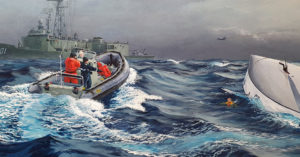
Painting: ‘The Life Line’ by Darrell White
The Creation of “The Life Line”
By Darrell White, ASMA
While participating in the Vendée Globe single-hand, around-the-world race, Tony Bullimore’s yacht Exide Challenger capsized on 5 January 1997. In the mountainous seas of the Southern Ocean 2,500 kilometres South-South-West of the West Australian coast, Bullimore was trapped in an air pocket underneath his overturned craft. Alerted by Bullimore’s distress beacon, the Australian Maritime Rescue Coordination Centre requested immediate assistance from the Australian Defence Force. Four days later a RAAF P-3 Orion and the frigate HMAS Adelaide closed on Bullimore’s stricken yacht to complete one of the most remarkable sea-rescues in Australian maritime history.
In March 2020, New Zealand went into COVID-19 lockdown, which meant we were confined to our homes for six weeks. Movement around the city was limited to one person per household for essential items only. On the upside, this proved to be a very productive time for my art. I had finished some seascapes and was looking for the next project. I also knew that the Australian Society of Marine Artists (ASMA) were planning their annual exhibition and I wanted to have a piece to exhibit that had an Australian theme.
I was cleaning out some of my old drawers and found a yellow A4 Navy envelope, addressed to Ross Shardlow, a fellow artist, mentor and good friend. It contained photographic references of HMAS Adelaide and the rescue of Tony Bullimore. It was instantly clear what my next piece would be. The timing was perfect. But how did I end up with this letter?
Back around 2008, when I lived in Western Australia, Ross and I were having one of our art and wine evenings. This would always involve looking through his studio and talking about upcoming works. He showed me a collection of photographs of Tony Bullimore being rescued.
I remembered serving at HMAS Stirling at the time when HMAS Adelaide was called upon to rescue the stricken yachtsmen. The idea of depicting an event that unfolded during my naval service was very appealing. I guess Ross thought, with my paintings and drawings of Royal Australian Navy themes, that it would be fitting for me to do the work.
To write this article, I called Ross to get the backstory to how he came to receive the images. Back to 2000, Bruce Stannard AM had a discussion with Ross about creating such a painting, which led to Bruce seeking some reference material. Bruce contacted Vic Jeffery OAM at HMAS Stirling, Garden Island, and Vic sent an envelope full of photos to Ross.
It was when Ross shared the photos that the idea of creating a painting got lodged in my mind. However, I had some commissions to finish first. Then I found myself planning a move to New Zealand with the family; executing the move and finally finding User Experience (UX) Design work (my fulltime occupation) once in Wellington. With all the turmoil that comes with such actions, the idea of painting the rescue of Tony Bullimore was stowed away until this year (2020).
Fresh from finishing the seascapes in relative quick time (for me) I started the initial composition work. Thinking I could mimic the same speed as the seascapes, I was soon reminded of the difference between them and the substantial research required for these types of works to allow for accurate compositing and depiction of the event. Add an exhibition deadline that specifically stated that the painting “must be dry”, I knew interesting times lay ahead for me.
I use acrylics because my ‘studio space’, being mainly the living room table, is shared with my young family. So, the low odour, water clean-up and fast drying qualities of the medium works well for my situation. I still work fulltime as a UX Designer, so my creative time is limited to after the kids’ bedtime. Some research and concept sketching was done during lunch breaks at work, which allowed for designated Art evenings to be utilised purely for painting.
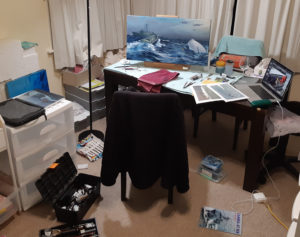
My studio space – “work with what you have”
The photographic references were of course invaluable in giving me a clear picture of the moment Tony Bullimore surfaced and the position of the rescue boat. However, I wanted HMAS Adelaide in frame. Problem was, all my reference shots were taken from Adelaide’s point of view. So, I decided to get creative and position the viewing point beyond the action, looking back at Adelaide.
I found a German documentary on YouTube with a great deal of video footage, including the P3 Orion passing overhead. This sparked the idea of having all of the assets involved in the rescue present in the composition. Through a combination of this video, the original reference material and online photos, I was able to assemble an accurate depiction.
I assumed the Phalanx close-in weapon system was deployed on board HMAS Adelaide, but I promptly removed it when I noticed its absence in a photo. The same image gave me the volume and colour of exhaust coming out of the funnel and uniforms of the crew lining the decks. Watching a video repeatedly to spot details like the position of the ship’s Seahawk, you quickly notice quirks in the editing of the video, such as footage of launching the ship’s boat for the rescue, which set out with a crew of three and returned with a crew of six and a yachtsman.
The composition went through several subtle inflight changes as I reworked the painting so the ship’s boat and Tony’s yacht were correctly scaled and positioned. As always, I find it is good practice after staring at a painting for so many hours to fire off an image of the work to Ross to get his feedback, and my sanity check. The work was completed two weeks before it was due to be boxed up and sent to Sydney.
The final painting shows HMAS Adelaide standing by in the background, with the P3 Orion off in the distance. The boat crew are circling around the yacht looking for signs of life after hammering on the hull. At the point of capture, the viewer is hovering just above the swell as Tony appears from underneath his yacht. One of the boat crew has spotted him as the coxswain steers the RHIB according to his direction.
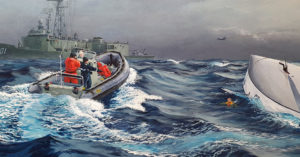
Detail of “The Life Line”
The ASMA’s 24th National Exhibition, “Seas of Change”, was held at the Royal Art Society of New South Wales in October 2020, and is an annual event.
TONY BULLIMORE – A REFLECTION
By Raydon Gates
When I first saw a photograph of Darrell White’s excellent painting ‘The Life Line’, many memories came flooding back around those extraordinary events of January 1997. Recounts of the rescue have been previously well covered in this journal, so I would like to reflect a little on Tony Bullimore post first meeting him deep in the Southern Ocean all those years ago.
My first impression of Tony, after the relief of the rescue of course, was his gregarious nature. Once he had recovered from the shock of his four day ordeal; plus starting to heal from his injuries of loss of part of a little finger, mild hypothermia, dehydration and frostbite on his fingers and toes, he immersed himself into the ship’s company. He would chat with everyone and anyone. He could often be found on the flight deck with a cup of tea in hand and bumming readily offered cigarettes, always ready to share a yarn. He was quite a sight in his grey coveralls offered by his adopted Petty Officers Mess, his HMAS Adelaide ball cap and big fluffy socks and open sandals protecting his damaged feet.
He became very much part of the crew; so much so that once it became known that HMAS Adelaide would be greeted on arrival by a large crowd of well wishes and a throng of international media, there was genuine concern that ‘our Tony’ would be cosseted and not overwhelmed by the attention. There was no reason for concern; Tony handled the mayhem with aplomb.
I recall the media conference on the wharf in front of more than 50 international journalists when he was asked how he would deal with his PTSD. He asked me in a whisper what did PTSD mean: when I explained he turned back to the media and being the ex-Royal Marine he was, replied “he would go down to the pub with a couple of the local lads and talk it through.” He was a tough old coot!
My wife Alison and I had the pleasure to share a quiet dinner in Fremantle with Tony and his wife Lalel before they returned home to United Kingdom. The owner of the restaurant requested that Tony and I sign a dinner plate that they would mount on the restaurant wall. Tony drew an upside down yacht and signed “this is how they found me – thank you Australia!”
Alison and I were fortunate to dine with Tony and Lalel again a few months later, this time in their home city of Bristol. Tony insisted we visit a famous local establishment, Harvey’s, which as well as a highly regarded restaurant had a wine cellar full of aged sherry casks. I recall we ended the night enjoying a fine sherry from the year of Alison’s birth. Of course decorum prevents me naming the year! A significant part of the evening for Tony was that he wore a pair of enclosed shoes for the first time since returning home: his frostbite injuries had (slowly) repaired and pleasingly he had not lost any toes. We stayed in touch with the Bullimores for many years as he continued his sailing adventures, always seeking new endurance records to break, plus concurrently planning his retirement in Lalel’s home country of Jamaica.
I will digress here to speak briefly about the other Vende Globe yachtsman we recued on that mission south, the Frenchman Thierry Dubois. I still recall my amazement as we circled Bullimore’s Exide Challenger when I turned around on the bridge wing to find Thierry standing beside me giving directions as to where Tony might be in the upturned hull. We had recovered Thierry by helicopter only five hours earlier! He had been exposed to the elements for four days, firstly tied to the rudder of his over turned yacht Pour Amnesty International and then alone in an eight man life raft; but his main concern was to be on the bridge to help a fellow competitor. They are a very resilient community those solo round-the-world yachtsmen! On our return journey to Fremantle Thierry was much more circumspect; he was comfortable to sit in my cabin and talk. This experience for him had underscored his mortality. He spoke of his intention upon return to France to marry his long-time girlfriend and start a family, create a legacy if you will. In January 1998 I received a post card from France which simply said “remember one year ago – thank you”. I was pleased to note in the competitors list of the following Vendée Globe sailing race: Thierry Dubois, France, married, one son!
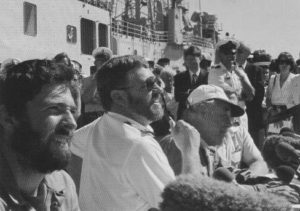
Undeterred by his near-death experience, Tony carried on with ocean racing, including another attempt to sail solo around the world in 2006. We discussed this and thought starting from Hobart would provide the necessary wind assistance to break the record. Unfortunately, again he had to abandon the attempt due to gear failure just east of New Zealand
Over the years Tony and I would reconnect over a documentary or a radio show on the BBC or our ABC as certain anniversaries arose. Never losing his love, or respect, of the sea Tony kept sailing until he was 78. He finally lost a battle – to cancer in July 2018, he was 79. He never got to retire to Jamaica.
His death lead to another media bombardment with many interview requests. I was honoured to recall a humble, robust and very talented man who loved life and knew how to live it to the full. He was a world class yachtsman with a well-deserved reputation for tenacity and success. Rest in Peace Tony Bullimore.
By Editor
The rescues of Thierry Dubois and Tony Bullimore would not have been possible without the support of HMAS Westralia commanded by CMDR Tony Ladomirski. Westralia replenished HMAS Adelaide on 11 January thereby enabling the frigate to effect a successful rescue.

HMAS Adelaide and HMAS Westralia in the Southern Ocean, January 1997, RAN image
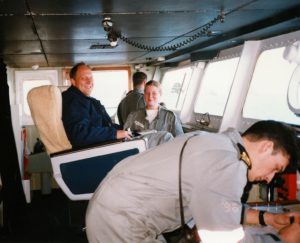
Further Reading
Semaphore: Search and Rescue: A Miracle in the South, SPC-A available at: https://www.navy.gov.au/media-room/publications/semaphore-search-and-rescue-miracle-south




